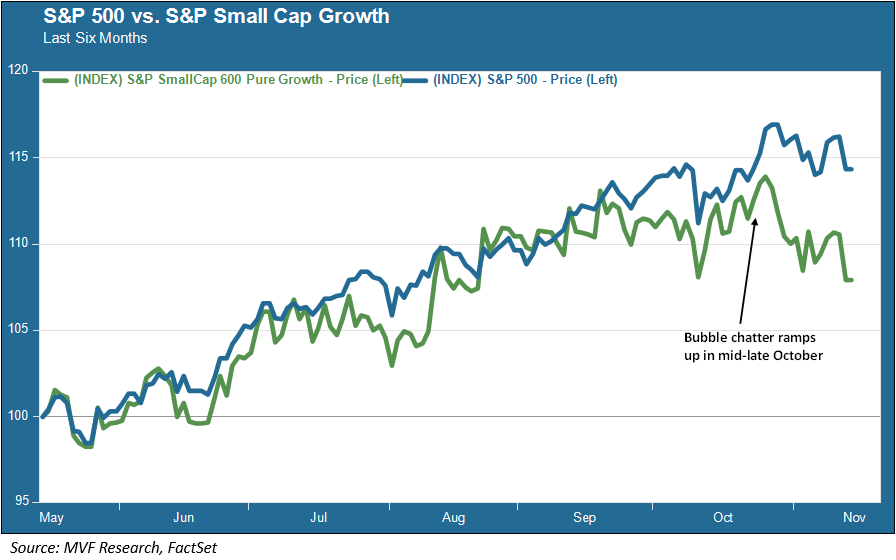
In the second half of October, the financial chattering class seized onto what seemed like a throwaway comment by OpenAI head Sam Altman during an interview. Responding to a question, Altman acknowledged that the AI space in the stock market was probably in bubble territory, though adding that while the space would probably go through some short-term pain, as generally happens with new technologies, the long-term use case remained extremely robust (it would be hard to imagine Altman, arguably the world’s leading evangelist for the bright shiny future of AI, to say otherwise).
In any event, financial pundits seized onto the “bubble” idea and ran with it. Investors for their part mostly ignored the bubble hype, though, and by the end of the month both the S&P 500 and the S&P Small Cap Growth index (where a number of the up and coming names in the space exist while they try to establish proof of concept) had reached their year-to-date highs. Shortly thereafter, however, the small cap index started to take a pronounced tumble. Yesterday the S&P 500 followed suit, and if today’s market open is any indication of how things end (which may or may not be the case, because even the future six hours ahead is unknowable), the blue chip index will end up down for the week.

Bad Vibes Take Charge
AI-related stocks (in both their large cap and small cap manifestations) have certainly taken much of the brunt for this week’s pullback, but the story is broader than that. The economic news – the data points that remain available during this prolonged absence of input from government agencies – has skewed to the downside. A weekly payroll estimates report from ADP reported an average decrease of 11,250 jobs per week during the four weeks up to October 25, adding support to last week’s job cuts report by Challenger, Gray and Christmas noting October’s large number of losses. Then the NFIB Small Business Optimism index came in at 98.2, below expectations and far below the almost giddy optimism small business owners reflected in the period immediately following last year’s presidential election. Small business owners have a great deal to worry about, from labor market concerns to tariffs and the lack of sufficient capital to pony up in today’s increasingly pay-to-play business-government nexus.
There has been a great deal of Fedspeak this week as well, with a number of FOMC voting members opining about the upcoming December meeting, and the market takeaway from much of the Fed commentary has tilted hawkish. The likelihood of a December rate cut, which a couple weeks ago was seen as a very high probability, is now more or less a coin flip. Along with the diminishing chances for a rate cut, the divergence of views among Committee members, resulting in a string of dissents at recent FOMC meetings, continues to be a subject of concern. Even with the government reopening this week, the question of when data from the BLS and BEA will become available remains unknown. Economic spokespersons from the White House do not seem at all eager to release a full set of data any time soon, leading to questions about what that data might tell us about the key issues of jobs and inflation.
Seasonality Still a Plus
For all the drama of Thursday’s big price moves on the major markets (with the potential for more today), the pullback thus far remains well short of a bull market correction (ten percent drop from the last peak) or even the five percent fall that we chronicle internally as a notable sentiment shift. We are still in the thick of what is frequently the most benevolent period of the year for stocks, with the holiday shopping season well underway (shouldn’t we just admit that now every day in November is Black Friday?) and window dressing as investment managers spruce up their portfolios before year end. That may still be enough to keep the headwinds of the purported AI bubble, downbeat macro data points and hawkish Fedspeak at bay. But there is plenty of volatility out there, and we have to be prepared for more twists and turns ahead as we head into 2026. For portfolios with long term objectives, this is a time to remain disciplined and unswayed by the day-to-day noise.